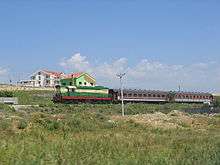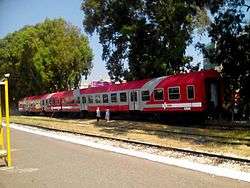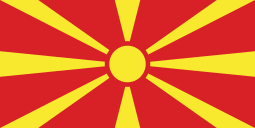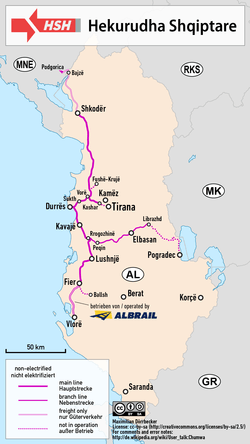Rail transport in Albania
The railways in Albania are administered by the national railway company Hekurudha Shqiptare (HSH) (Albanian: Albanian Railways). It operates a standard-gauge railway gauge (1,435 mm (4 ft 8 1⁄2 in)) rail system in Albania. All trains are hauled by Czech-built ČKD diesel-electric locomotives.
| Rail transport in Albania | |||||||
|---|---|---|---|---|---|---|---|
 HSH train on the Tirana-Durrës line | |||||||
| Operation | |||||||
| National railway | Hekurudha Shqiptare | ||||||
| Statistics | |||||||
| Ridership | 650,000 (2017)[1] | ||||||
| Passenger km | 32 million (2017)[1] | ||||||
| Freight | 0.34 million tonne-km (2017)[1] | ||||||
| System length | |||||||
| Total | 424 kilometres (263 mi)[1] | ||||||
| Double track | 0 km (0 mi)[1] | ||||||
| Electrified | 0 km (0 mi)[1] | ||||||
| Track gauge | |||||||
| Main | 1,435 mm (4 ft 8 1⁄2 in) standard gauge | ||||||
| High-speed | 1,435 mm (4 ft 8 1⁄2 in) | ||||||
| |||||||
The small system was considered by many travel guides as a tourist attraction and de facto a panoramic train journey, however the railway from Elbasan to Pogradec, the most beautiful part of railway, was closed in 2012 due to the poor condition of the line and the structures along it.[2]
There is only one international link, with Montenegro, the Podgorica–Shkodër railway, which has only ever been used for freight traffic, and whose last station in Albania is the Bajzë Rail Station.
History
Before 1947, Albania was the only country in Europe not to have a standard rail service, although some narrow (decauville) gauge lines were built during World War I.[3] In 1947, Albania's first standard gauge line was opened.
The railway system was extensively promoted by the government of Enver Hoxha, during which time the use of private motor transport was effectively prohibited. By 1987, 677 km of track was constructed, linking the main urban and industrial centres. Train transport was the main transportation method until the collapse of Communism in 1990.
After 1991, the railway network fell into disrepair. Since 1991, there was a considerable increase in car ownership and bus usage. Whilst some of the country's secondary roads are still in a very poor condition, there have been other developments (such as the construction of a motorway between Tirana, Durrës, and other towns) which have taken much traffic away from the railways.
As of 2015, some stations and rolling stock along the Durrës–Tiranë railway line was being renovated and coloured red and white.
Timeline

- November 1947 - Opening of the first standard gauge railway line (Durrës to Peqin).
- June 1957 - Introduction of diesel-electric locomotives.
- July 1973 - Completion of the railway line from Elbasan to Prrenjas, the first Albanian line through the mountains.
- September 1986 - First international rail freight (to and from Montenegro, then part of Yugoslavia).
- 2000 - HSH ceases to be a state enterprise, becoming a limited company (although state owned).
- 2005 - Other rail operators allowed track access.
Present day network
The HSH passenger system presently consists of the following lines:
- Shkodër–Vorë railway – from Shkodër County via Durrës, Rrogozhinë, Fier to Vlorë (Fier-Vlorë is closed for personal transport, some parts also work only in summer)
- Rrogozhinë – Elbasan (Elbasan-Pogradec extension has been closed)

The rails from the line Milot–Rubik–Rrëshen have been partially removed to repair the line to Montenegro. The line should have led to the Nuclear Power Plant of Klos, but was never finished.
- Durrës–Kashar – extension Kashar–Tirana is no longer operational as of September 2013. Tirana station has been demolished to make way for a new road project. A rail replacement bus service is available outside what is left of Tirana station to Kashar to catch onward rail connections. The bus service operates between the two localities as part of the (Durrës–Tiranë railway).
The Librazhd-Pogradec line, the most beautiful part of the Albanian railway network was closed for passenger traffic in 2012. The stored locomotives and wagons from Prrenjas are being moved to Elbasan. As a result, the railway is probably going to be dismantled, as it doesn't link any major cities.
There are several freight-only branch lines. Regular freight trains run between Podgorica and Shkodër every weekday (with an Albanian or a Montenegrin locomotive alternating daily) and between Durrës and the oil refinery at Ballsh about once a week. The Tirana-Shkodër and the Durrës-Elbasan lines are normally served by mixed trains.
The UIC Country Code for the Albanian railway system is 41.
According to the Albanian passengers trains timetable for 2019, the only connections in operation were Durres to Shkoder, Elbasan and Kashar.[4]
Future
It was announced that the Tirana-Durres line would be rehabilitated with a loan of €35.9 million from the European Bank for Reconstruction and Development and a €35.5 million grant from the Western Balkans Investment Fund. The grants would also fund the construction of the Tirana-Rinas Line.[5] The lines will come complete with level crossings and signals to improve safety and reliability.[6] No specific date has been given on when construction would begin.
On 9 October 2018, the Feasibility Study for rehabilitation of the Durres-Rrogozhine-Elbasan-Pogradec railway line was presented, funded by European Commission funds, made available through the Western Balkans Investment Instrument. A pre-feasibility assessment was completed for the 151 km (94 mi) Durres to Pogradec line. The focus was on the 72 km (45 mi) line between Durres, Rrogozhines and Elbasan. The remaining 79 km (49 mi) from Elbasan in Pogradec is out of service due to the poor condition of the line and the bridges and tunnels along it. The Durres Segreg-Rrogozhine segment was rated the highest priority for rehabilitation. The focus of investment will be the 33.5 km (20.8 mi) section from Durres - Rrogozhine. The rehabilitation cost is estimated at EUR 52 million which will meet European Network design standards at speeds of 100 km/h (62 mph) and axle load of 22.5 tons. Travel time will be reduced from 60 min to 32 min. The flow along this segment is expected to reach 330,000 passengers and 1,100,000 tons of goods by 2047. Estimated value in time saving for users of the Albanian transport system will be 0.65 million euros for travelers and 15.3 million euros for freight transport. Additional savings from the reduction in the cost of operating vehicles in road transport are estimated at EUR 0.5 million for travelers and EUR 8.7 million for freight transport.[7]
Statistics
Usage of the railway network of Albania is declining year by year.[8]
| 1950 | 1965 | 1970 | 1975 | 1980 | 1985 | 1989 | 1993 | 1994 | 1995 | 1996 | 1997 | 1998 | 1999 | 2000 | 2001 | 2002 | 2003 | 2004 | 2005 | 2006 | 2007 | 2008 | 2009 | 2010 | 2011 | 2012 | 2013 | ||
|---|---|---|---|---|---|---|---|---|---|---|---|---|---|---|---|---|---|---|---|---|---|---|---|---|---|---|---|---|---|
| Passengers | in thousands | 3,961 | 4,022 | 3,739 | 3,389 | 1,820 | 2,269 | 2,270 | 2,381 | 2,676 | 2,270 | 2,070 | 1,758 | 1,440 | 1,659 | 1,091 | 822 | 645 | 430 | 453 | 448 | 329 | |||||||
| in millions pass.-km | 223 | 215 | 197 | 168 | 95 | 116 | 121 | 125 | 138 | 123 | 105 | 89 | 73 | 80 | 51 | 41 | 32 | 19 | 18 | 16 | 12 | ||||||||
| Freight | in thousands tonnes | 539 | 522 | 574 | 521 | 284 | 305 | 361 | 412 | 258 | 340 | 520 | 417 | 404 | 450 | 399 | 355 | 343 | 403 | 317 | 142 | 151 | |||||||
| in millions ton.-km | 54 | 53 | 53 | 42 | 23 | 25 | 27 | 28 | 19 | 21 | 31 | 32 | 26 | 36 | 53 | 52 | 46 | 66 | 50 | 25 | 23 | ||||||||
| Network length[9] | in kilometres | 115 | 143 | 193 | 272 | 319 | 421 | 447 |
Rail links to adjacent countries
Neighbouring railways have the same gauge.




See also
References
- "Railway Statistics – 2017 Synopsis" (PDF). International Union of Railways, IUC. 2017. Retrieved 11 June 2019.
- "Njoftim për shtypin". Hekurudhat Shqiptare. 11 October 2018.
- https://sivenas.wordpress.com/2017/02/19/the-almopia-decauville-train/
- "PASSENGERS TRAINS TIMETABLE FROM 1 APRIL2019". hsh.com.al. Retrieved 16 July 2019.
- Press, Associated (2018-05-10). "EU, EBRD fund Albania's main rail link upgrade". Washington Post. ISSN 0190-8286. Retrieved 2018-05-10.
- "9072-PRE-48466". www.ebrd.com. Retrieved 2018-05-10.
- "Njoftim Për Shtypin". Hekurudhat Shiqiptare. Hekurudhat Shiqiptare. 11 October 2018. Retrieved 18 December 2018.
- Railway transport of goods and passengers (1993-2013). INSTAT (Institute of Statistics). Tirana, Albania
- Sako Z. Ilir MBA MSc (2008), Railway market: Albanian Railways - a difficult heritage
External links
| Wikimedia Commons has media related to Rail transport in Albania. |

